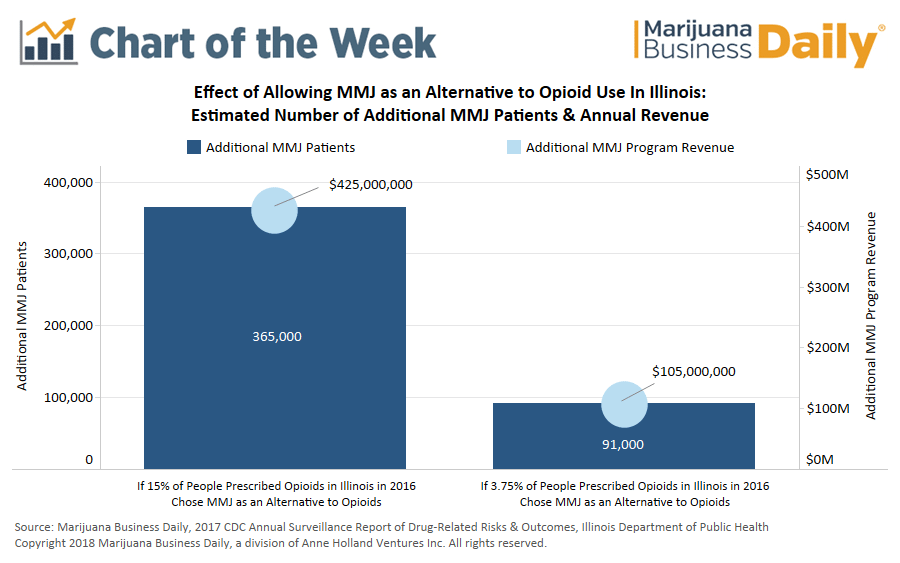Cannabis Science, Health and Wellness News, Industry News, Politics, Research
Chart: Medical cannabis as alternative to opioids could give Illinois’ MMJ program a massive boost
Pending legislation in Illinois that would allow medical marijuana as an alternative to opioid prescriptions could fundamentally alter the business landscape in the state.
The move could potentially add tens of thousands of new patients to the MMJ program and eventually generate hundreds of millions in additional sales.
The Illinois General Assembly on May 31 passed SB 0336, a pilot program authorizing individuals to use medical cannabis as an alternative to opioids. The bill awaits the signature of Republican Gov. Bruce Rauner, who has been hesitant to expand Illinois’ MMJ program in the past.
Though Rauner may eventually veto the measure, it’s worth considering how passage of the bill could impact the MMJ business climate.
A similar measure is in development in New York, and states throughout the country are looking for ways to reduce the use of opioids and fight opioid-related overdose deaths, which have risen dramatically in recent years.
According to the Centers for Disease Control and Prevention (CDC), about 19% of the U.S. populationhad at least one opioid prescription filled in 2016. At that rate, roughly 2.4 million Illinois residents would qualify to use MMJ as an alternative, based on the state’s population of 12.8 million.
While there’s little chance of every qualified patient opting for the cannabis alternative, the expansion opportunity is still enormous.
Combining data from the CDC and state MMJ programs that track patient counts by condition shows that, on average, about 15% of individuals with cancer enroll in these programs when available.
If Illinois residents enrolled in the MMJ program as an alternative to opioid use at the same rate as cancer patients, that translates into roughly 365,00 new patients – nearly 10 times the number currently enrolled.
Enrollment at even a quarter of what’s observed in cancer patients – 3.5% – would result in more than 90,000 additional MMJ patients in Illinois.
Under the Illinois bill, patients would not be enrolled indefinitely. Instead, those given an opioid prescription for 30 days or more – including any refills or renewals – would have access to the MMJ program for twice the length of the opioid prescription.
According to the CDC, the average person who received an opioid prescription in 2016 filled 3.5 prescriptions over the course of the year, each containing an average of 18 days of supply, for a total of just over a two-month supply of opioids.
Based on those figures, the average person would be able to purchase MMJ for approximately four months in Illinois.
Data from Illinois’ program suggest that current patients spend an average of $3,500 per year on MMJ, or about $70 per week. If new patients using medical cannabis as an alternative to opioids spent the same amount per week, the result would be just over $1,100 per patient per year in additional sales.
Read more from the source: https://mjbizdaily.com


